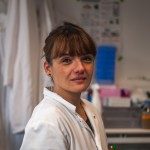Link to Pubmed [PMID] – 25732627
Tuberculosis (Edinb) 2015 Feb;
Pathogenesis of Mycobacterium tuberculosis depends on the secretion of key virulence factors, such as the 6 kDa early secreted antigenic target ESAT-6 (EsxA) and its protein partner, the 10 kDa culture filtrate protein CFP-10 (EsxB), via the ESX-1 secretion system. ESX-1 represents the prototype system of the recently named type VII secretion systems that exist in a range of actinobacteria. The M. tuberculosis genome harbours a total of five gene clusters potentially coding for type VII secretion systems, designated ESX-1 – ESX-5, with ESX-4 being the most ancient system from which other ESX systems seem to have evolved by gene duplication and gene insertion events. The five ESX systems show similarity in gene content and gene order but differ in function. ESX-1 and ESX-5 are both crucial virulence determinants of M. tuberculosis, but with different mechanisms. While ESX-1 is implicated in the lysis of the host cell phagosomes, ESX-5 is involved in secretion of the mycobacteria specific PE and PPE proteins and cell wall stability. Research on type VII secretion systems has thus become a large and competitive research topic that is tightly linked to studies of host-pathogen interaction of pathogenic mycobacteria. Insights into this matter are of relevance for redrawing the patho-evolution of M. tuberculosis, which might help improving current strategies for prevention, diagnostics and therapy of tuberculosis as well as elucidating the virulence mechanisms employed by this important human pathogen.




